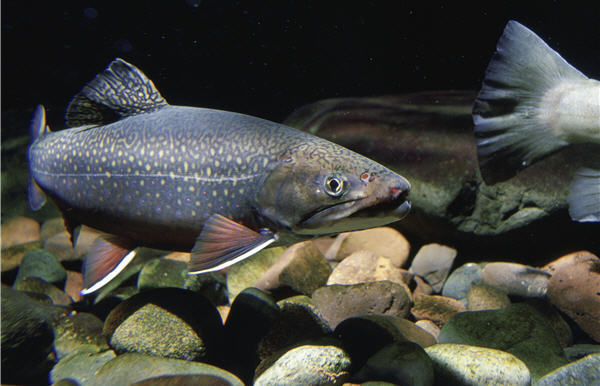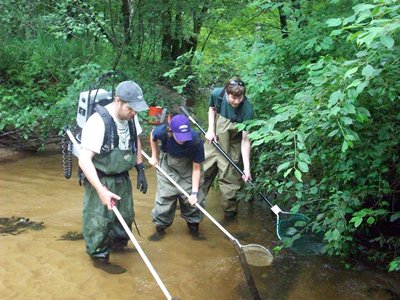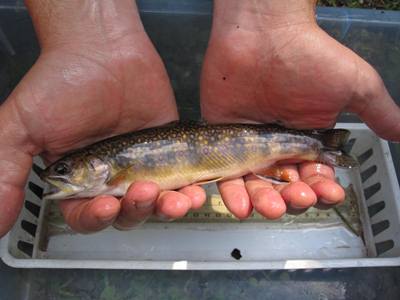The Wrack
The Wrack is the Wells Reserve blog, our collective logbook on the web.
The Wrack is the Wells Reserve blog, our collective logbook on the web.
It’s that time of year… fall is in the air and (if you’re a brook trout) love is in the air too! October and November is prime spawning time for Eastern Brook Trout. They’ve been fattening up all summer on aquatic insects. Now the mature females have bellies full of eggs and are looking for a spots with cold, clear water and loose, clean gravel where they can make their nests, called redds.
The Wells Reserve research team was out looking for redd-worthy gravel in the Merriland River and Branch Brook this summer. Generally, this involved feeling around on the bottom of the stream or using a "sediment scoop" (i.e., a tin can screwed to the end of a stake). Brook trout gravel had to be the right size and could not be stuck in mud, since the fish have to be able to move it around to cover their eggs. We also measured the quality of the water, including oxygen and temperature, and set traps to capture the aquatic insects that the trout like to eat. I'll be spending some time with a microscope to identify and count all the bugs that we caught!
As I was blindly feeling around for gravel on the stream bottom during one of our field days, I thought about snapping turtles and other things that bite, but I also thought about the brook trout that would be using the gravel as shelter for their eggs. Some brook trout will travel many miles upstream to find a suitable spawning habitat.
 (Photo: USFWS)
(Photo: USFWS)
The males show up first in great numbers to stake out their territories. At breeding time, they put on brilliant reddish-orange colors and develop a hooked jaw called a kype. When the females arrive, they choose a suitable male with nice gravel and the couple courts by swimming in circles, clearing silt and debris from their nesting area in the process. When the courtship is over, the female swishes her tail to make the first redd. She deposits her eggs and the male fertilizes them. This process is repeated until the female lays all her eggs - up to 5,000 for a large female! Check out this cool video of brook trout spawning.
The eggs remain in the gravel through the winter and after about three months, they hatch into sac fry (baby trout that have a nutritional sac like a yolk). In mid-spring, about 6-8 weeks after hatching, the fry have used up their yolk sacks and emerge from the gravel to find food. When they are a bit larger, the young fish are called parr for the vertical dark bands or “parr marks” that appear on their sides to provide camouflage. We caught many brook trout parr when we were electrofishing in the Merriland River and Branch Brook.


It takes up to three years for the brook trout to grow big enough to spawn, depending on their habitat. Some brook trout are known to travel downstream to estuaries in order to find food. These “sea-run” brook trout may grow faster than those that remain in upstream habitats, but scientists still have much to learn about these ocean-going populations. Check out this video that summarizes the brook trout life cycle.
Have you fallen in love with the Eastern Brook Trout yet? Many people have. They’re attractive, fun to fish for, and are the only native trout in the eastern United States. They’re also important links in food webs and good indicators of water quality. If you have a healthy brook trout population, that's a sign that your stream is in good condition.
Fortunately, we still have some gorgeous brook trout habitat here in southern Maine, but it faces an uncertain future as human development increases. In addition, increased water temperatures due to climate change may restrict the range of these cold-loving fish, and barriers such as dams and poorly-constructed road-stream crossings can block fish from accessing important habitats.
The more we know, the more we can do to conserve Eastern Brook Trout and their habitats. Keep your eyes out and you might see brook trout spawning in a stream near you! Check out this video so you can know what brook trout spawning looks like from a fisherman’s perspective.